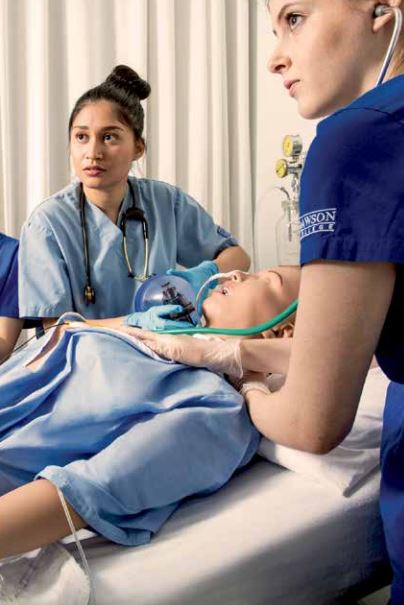Articulation
• Realistic articulation
• Range of motion in hips, knees, ankles,
shoulders, elbows and wrist
• Cervical motion for practice of patient
stabilization
Airway
• Oral and dental hygiene
• Nasal packing
• Bag-valve-mask (BVM) ventilation
• Nasopharyngeal and oropharyngeal
airway placement
• Endotracheal tube placement
• Tracheostomy tube placement
• Endotracheal tube and tracheostomy
tube suctioning with fluids
Breathing
• Manual bilateral chest rise and fall
with BVM ventilation via face mask,
endotracheal tube and tracheostomy
tube
• Bilateral chest tube insertion for care
and maintenance
Cardiac (Live/Complete)
• Defibrillation and cardioversion via
software
• 4-lead ECG monitoring with real
equipment
• 12-lead dynamic ECG display
Circulation
• Unilateral blood pressure measurement
by auscultation and palpation
• Bilateral carotid pulses (manual)
• Unilateral radial and brachial pulses with
programmable intensities (Live/Complete)
• Unilateral subclavian catheter insertion
for care and maintenance
Gastric
• Nasogastric tube insertion and gastric
lavage and gavage with real fluids
• Ostomy care and irrigation of a variety
of configurable stomas
• Enema administration with fluids
Medication Administration
• Eye and ear irrigation
• Six intramuscular sites for medication
administration in bilateral deltoids,
bilateral vastus lateralis, ventrogluteal
and dorsogluteal sites
Urinary
• Urinary catheterization with fluids
• Interchangeable genitalia
Vascular Access
• Unilateral IV cannulation at antecubital
and dorsum of hand
• Fluid and medication administration
• Blood draw with vacuum sealed blood
collection system
Sounds (Live/Complete)
• Auscultation of normal and abnormal
heart, lung and bowel sounds
• Prerecorded speech and vocal sounds
• Bidirectional audio communication
between manikin and operator
caehealthcare.com
Standard Equipment
CAE Juno wireless and tetherless manikin:
medium and dark skin tones available
New software platform CAE Maestro –
instructor driven
Includes 10 Simulated Clinical Experiences
– Chronic heart failure exacerbation
– Gastrointestinal bleed secondary to
esophageal varices
– Skills validation
– Asthma management of patient in
home care setting
– Postoperative care of the patient with
complications: pneumonia
– Suctioning and tracheostomy care
with hypoxia
– Basic assessment of the hip
replacement patient
– Postoperative care of the patient with
a ruptured diverticulum
– Seizure disorder and moderate
learning disability
– Dementia and urinary tract infection
in a patient with DNR orders





